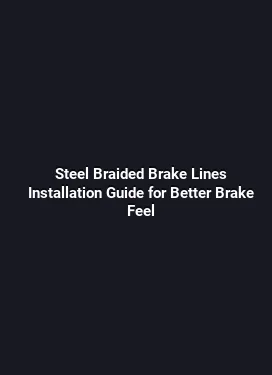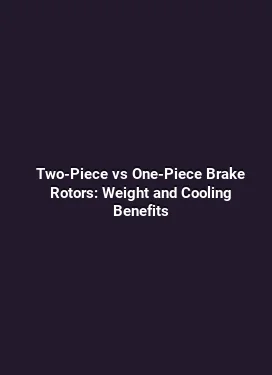How to Fix Brake Fade Issues on Mountain Roads: Complete Guide
Mountain riding places unique demands on braking systems. When gradients tighten, switchbacks demand precise modulation, and long descents test rotor temperatures, brake fade can quickly undermine control. This guide dives into the mechanics behind brake fade, explores practical diagnostics, and provides actionable maintenance and riding techniques to maintain reliable stopping power on challenging mountain routes.
Understanding Brake Fade on Mountain Roads

Brake fade happens when the performance of braking materials degrades due to heat, moisture, or fluid dynamics, resulting in a reduction of stopping power. On mountain descents, repeated heavy braking elevates rotor temperatures, softens pad friction, and can loft the brakes into a regime where heat exceeds the optimum window for friction. Mountain bikes and vehicles share the same physical principles, but the specifics of weight transfer, tire grip, and suspension interaction add layers of complexity. Recognizing the signs—longer stopping distances, spongy feel, occasional squirm in the lever or pedal, and a distinct heat-on-metal sensation—helps riders intervene before a critical moment arises.
Thermal fade is one of the most common culprits on steep grades. The friction coefficients between pad and rotor drop as temperature rises, leading to decreased grip. In addition, moisture or contaminated pads can exacerbate fade, especially when rain follows a long downhill where rotor surfaces remain hot and dry. Understanding these fundamentals informs both maintenance routines and riding strategies designed to manage heat more effectively during mountain treks.
Key Factors Contributing to Brake Fade

There are several interacting factors that influence fade severity. Rotor design, pad composition, fluid quality, hose integrity, and overall system volume all play a role. A common pattern involves the cycling of high-intensity braking followed by cooling periods; repeated heating and cooling cycles can create microcracks, trap air, or degrade pad surfaces. Even ambient conditions—ambient temperature, humidity, and wind exposure—impact rotor cooling. In the context of trail riding or enduro routes, weight distribution during cornering and braking at the apex can push the front brake to perform well beyond its usual duty cycle, accelerating fade if not anticipated.
Evaluating the Brake System: A Systematic Diagnostic Approach
Effective fixes begin with a structured assessment. The aim is to determine whether fade is primarily a heat-related issue, a hydraulic or pneumatic fluid concern, pad/rotor wear, or a combination of these factors. A clear diagnostic method helps in prioritizing corrective steps and selecting the most impactful interventions for mountain riding scenarios.
Start with a visual and tactile inspection of components. Look for glazing on pad faces, rotor scoring, blue tinting, or unusual wear patterns. Check for fluid leaks around the master cylinder and caliper seals, and ensure brake hoses show no cracks or bulges. Spin the wheel and apply the brakes gently to feel for consistent modulation; any sponginess, air intrusion, or inconsistent bite suggests bleed or air-related issues. Finally, measure rotor runout and ensure calipers center over the rotor; misalignment can cause uneven wear and reduced cooling efficiency.
Heat Management: Rotor Temperature and Cooling
Heat management is central to preventing fade. On long descents, rotor temperatures can rise rapidly, degrading frictional properties. Practical steps include choosing appropriate rotor sizes for the terrain, inspecting air flow around the rotor and caliper area, and ensuring vents or fins on rotor designs function as intended. Riders should consider ride pacing that alternates braking with periods of reduced brake engagement to allow partial cooling, while maintaining control through engine braking or weight transfer techniques where applicable.
Cooling effectiveness depends on air flow and rotor exposure. Shields, mud guards, or protective covers that restrict airflow to the rotor can unintentionally trap heat. Regular cleaning to remove mud or debris that blankets rotor surfaces also aids cooling. For some setups, lighter colored rotors may dissipate heat a bit more efficiently, while certain coatings can influence heat absorption characteristics. While not a replacement for proper technique, optimized cooling reduces the likelihood of fade during extended descents.
Pad and Rotor Compatibility: Material Choices and Wear Patterns
Pad material selection directly impacts friction stability across heat cycles. Sintered pads typically perform well in high-heat conditions common on mountain roads, maintaining friction at elevated temperatures. Organic or resin pads tend to provide strong bite at lower temperatures but can fade more quickly when overheated. The rotor material and design—nostalgia for cross-drilled or slotted surfaces versus solid rotors—affect cooling efficiency and pad wear. It’s essential to pair pads with rotors that complement each other and to replace worn components before the fade threshold is approached.
Wear patterns reveal usage history. A rotor with consistent scoring and glazing indicates that pad material has overheated and then deposited residues onto the metal surface. This glazing reduces friction efficiency and can trigger longer braking distances in subsequent climbs or descents. Regular inspection of pad thickness and rotor surface condition ensures timely replacements, reducing the risk of sudden fade during critical sections of a mountain route.
Maintenance Practices to Mitigate Brake Fade
Proactive maintenance is the foundation of reliable braking in mountainous terrain. The following practices address the core causes of fade and help sustain consistent performance across diverse conditions.
1) Regular pad and rotor inspection: Measure pad thickness and inspect rotor surface for glazing, scoring, or warp. Replace when pads are thin or rotors show significant wear. Consider rotating or resurfacing rotors if they display consistent runout or heat-related deformation.
2) Fluid health and bleeding: If hydraulic braking shows sponginess, air may be trapped in the lines or the fluid may have absorbed moisture. Bleeding the system with fresh brake fluid suited to the brake type helps restore consistent lever feel. Use a clean container, proper fittings, and follow manufacturer guidelines for sequence and torque values. A routine bleed schedule aligned with riding frequency and climate can prevent fade caused by degraded fluid quality.
3) Clamp and hose integrity: Inspect caliper pistons for smooth retraction, and verify that hose passages are free from kinks or bulges. Any stiffness during lever actuation or disconnection between lever input and pad response may indicate internal or external hose restrictions that hamper cooling and fluid movement.
4) Caliper alignment and rotor runout: Ensure calipers are centered over the rotor. Misalignment leads to uneven pad wear and reduced cooling efficiency. Use a dial indicator to verify rotor runout within manufacturer tolerances, and reseat the caliper if needed after removing and reinstalling components.
5) Airflow optimization: Evaluate the mounting area for obstructions that block air contact with rotors. Remove dirt, mud, or debris that can insulate the rotor surface. In some cases, simple adjustments to fenders or guards can improve airflow and cooling during descents.
Bike Setup and Material Synergy for Mountain Riding
Beyond routine maintenance, choosing compatible brake components tailored to mountain conditions matters. A balanced system with adequate leverage, rotor diameter, and pad selection helps manage heat more predictably. Consider a rotor size that provides the necessary heat capacity for expected descent lengths. In addition, lever reach and modulation characteristics should align with rider preferences and hand strength to maintain precise control during braking maneuvers on tight switchbacks.
Suspension setup also contributes to braking stability. A well-tuned fork and shock minimize weight transfer variability and help keep tire grip stable during deceleration. When the bike remains planted and the front wheel maintains traction, the braking system operates more efficiently, reducing the tendency toward fade on steep sections.
Riding Techniques to Reduce Brake Fade During Descent
Technical riding skills complement mechanical fixes. Implementing smart braking techniques and learning how to manage heat through riding style can significantly reduce fade risk. These practices are especially valuable on mountain roads where terrain changes rapidly and the margin for error is small.
Start with progressive braking: apply steady, controlled pressure rather than abrupt, aggressive pulls. This approach minimizes heat spikes and maintains rotor temperature within the frictional sweet spot. Anticipate braking zones by scanning ahead and planning deceleration gradually as you approach corners or steep sections.
Utilize engine or bodyweight management when possible. In vehicles, engine braking can supplement brake use. In bicycles, technique involves weight transfer and body positioning to optimize braking efficiency while preserving tire grip. Reducing speed before corners helps maintain control without forcing heavy, high-heat braking at the apex.
Implement cooling breaks after long downhill stretches. If the route allows, light throttling or easing off the brakes to allow partial cooling between high-intensity sections can prevent the rotor temperature from climbing excessively. This tactical approach complements mechanical maintenance and ensures consistent performance across the descent.
Brake modulation practice on varied surfaces—loose gravel, wet patches, and damp leaves—builds a feel for how brakes respond under different heat and friction conditions. Regular practice helps riders interpret subtle changes in lever feedback and adjust pressure accordingly, reducing the likelihood of fade in real-world mountain scenarios.
Emergency Procedures and Contingency Plans
While prevention is ideal, having a plan for fade-related incidents improves safety. If brake performance deteriorates during a descent, reduce speed gradually, shift weight to maximize tire contact, and avoid aggressive cornering. If the lever becomes increasingly soft or spongy, consider a controlled stop at a safe stretch of the route, inspect the system for leaks, overheating, or leaks, and retest after cooling. Carrying basic tools and spare parts—fluid appropriate for the system, a bleed kit, and spare pads—can be crucial in remote mountain environments.
For riders who frequently tackle extreme grades, consider maintaining a backup braking option or planning routes with alternative descents in case of temporary brake impairment. While not a substitute for proper maintenance, prudent route planning reduces risk when fade becomes a factor during a ride.
Trend Insights and Semantics in Brake Systems
In the current landscape, brake systems are influenced by evolving materials, rotor geometries, and coating technologies that improve heat management and friction stability. The emphasis on thermal resilience, pad-to-rotor compatibility, and cooling efficiency reflects a broader trend toward rideable, predictable braking under varied climate conditions. Semantically, discussions around brake systems often touch on terms such as heat buildup, friction stability, braking modulation, and rotor cooling—concepts that describe the interplay between physics and rider inputs. Keeping abreast of these developments helps riders select components and techniques aligned with modern performance expectations.
Riders who engage in off-road or mountain riding benefit from embracing a holistic approach: combining well-maintained hardware with deliberate riding strategies and route planning. This integrated method yields safer descents, shorter stopping distances, and more consistent feedback from the brakes across a wide range of speeds and gradients.
Best Practices for Long-Term Brake System Health
Adopt a maintenance cadence that matches riding frequency and terrain demands. Schedule brake fluid checks and pad/rotor inspections at regular intervals, especially after lengthy descents or exposure to muddy, wet environments. Keep a clean workspace and maintain a log of component lifespans to anticipate replacements before performance degrades. Finally, stay engaged with community forums and manufacturer advisories to learn about new materials or configurations that might enhance fade resistance without sacrificing control.
In summary, mitigating brake fade on mountain roads hinges on a combination of proactive maintenance, strategic riding techniques, and informed component choices. By addressing heat management, pad-rotor compatibility, hydraulic health, and riding discipline, riders can sustain reliable braking performance across demanding mountain routes and enjoy safer, more confident descents.






